The Effects of Rapid Urbanization on Forest Landscape Connectivity in Zhuhai City, China
Abstract
1. Introduction
2. Materials and Methods
2.1. Study Area
2.2. Data sources and Processing
2.3. Index of Landscape Connectivity
2.3.1. Integral Index of Connectivity (IIC)
2.3.2. Probability of Connectivity (PC)
2.3.3. Patch Importance
2.4. The Threshold Distance and Patch Size Classification
2.5. Constructing the Ecological Corridor Based on the Important Nodes
2.6. Statistical Analysis of Functional Connectivity Metrics
3. Results
3.1. Spatiotemporal Distribution of Forest Patches
- The forest coverage rate in the natural reserve and forest parks in Fenghuang Mountain and Huangyang Mountain increased to at least 85% and the areas of the natural reserve enlarged. The same measures were implemented in other mountains in Zhuhai City.
- The eco-environment in Qiao island which is located in the northeast part of Zhuhai City had been recovered and improved. Other plans had been made such as forbidding destroy the plants in mountains, rescuing the destroyed forest land and restoration projects, similar measures had been adapted and implemented in another island such as Gaolan island.
- The quarries in natural reserve were closed and the destroyed eco-environment in these places was restored through planting the suitable tree species and implementing the ecological restoration work.
3.2. Analysis of the Threshold Distance
3.3. Dynamics of Forest Landscape Connectivity from 1999 to 2013
3.4. Dynamics of Patch Importance Based on the dIIC Value
3.5. Construction of Ecological Network Based on Forest Distribution
3.6. Other Factors Which Could Also Affect the Patch Importance
Author Contributions
Funding
Acknowledgments
Conflicts of Interest
References
- Seto, K.C.; Michail, F.; Burak, G.; Reilly, M.K. A Meta-Analysis of Global Urban Land Expansion. PLoS ONE 2011, 6, e23777. [Google Scholar] [CrossRef] [PubMed]
- Schell, L.M.; Ulijaszek, S.J. Urbanism, urbanisation, health and human biology: An introduction. In Urbanism, Health and Human Biology in Industrialised Countries; Cambridge University Press: Cambridge, UK, 1999. [Google Scholar]
- Li, J.; Deng, X.; Seto, K.C. Multi-level modeling of urban expansion and cultivated land conversion for urban hotspot counties in China. Landsc. Urban Plan. 2012, 108, 131–139. [Google Scholar]
- Clergeau, P.; Burel, F. The role of spatio-temporal patch connectivity at the landscape level: An example in a bird distribution. Landsc. Urban Plan. 1997, 38, 37–43. [Google Scholar] [CrossRef]
- Song, W.; Chen, B.; Zhang, Y.; Wu, J. Establishment of Rural Housing Land Standard in China. Chin. Geog. Sci. 2012, 22, 483–495. [Google Scholar] [CrossRef]
- Shahbaz, M.; Sbia, R.; Hamdi, H.; Ozturk, I. Economic growth, electricity consumption, urbanization and environmental degradation relationship in United Arab Emirates. Ecol. Indic. 2014, 45, 622–631. [Google Scholar] [CrossRef]
- Wang, S.J.; Ma, H.; Zhao, Y.B. Exploring the relationship between urbanization and the eco-environment—A case study of Beijing–Tianjin–Hebei region. Ecol. Indic. 2014, 45, 171–183. [Google Scholar] [CrossRef]
- Zhou, D.; Shi, P.; Wu, X.; Ma, J.; Yu, J. Effects of urbanization expansion on landscape pattern and region ecological risk in Chinese coastal city: A case study of Yantai city. Sci. World J. 2014, 2014, 821781. [Google Scholar] [CrossRef] [PubMed]
- Daily, G.C. Introduction: What Are Ecosystem Services; Resources for the Future: Washington, DC, USA, 1997. [Google Scholar]
- Dobbs, C.; Escobedo, F.J.; Zipperer, W.C. A framework for developing urban forest ecosystem services and goods indicators. Landsc. Urban Plan. 2012, 99, 196–206. [Google Scholar] [CrossRef]
- Hladnik, D.; Pirnat, J. Urban forestry—Linking naturalness and amenity: The case of Ljubljana, Slovenia. Urban For. Urban Green. 2011, 10, 105–112. [Google Scholar] [CrossRef]
- Löfvenhaft, K.; Björn, C.; Ihse, M. Biotope patterns in urban areas: A conceptual model integrating biodiversity issues in spatial planning. Landsc. Urban Plan. 2002, 58, 223–240. [Google Scholar] [CrossRef]
- Gagné, S.A.; Eigenbrod, F.; Bert, D.G.; Cunnington, G.M.; Olson, L.T.; Smith, A.C.; Fahrig, L. A simple landscape design framework for biodiversity conservation. Landsc. Urban Plan. 2015, 136, 13–27. [Google Scholar] [CrossRef]
- Li, F.; Wang, R.; Paulussen, J.; Liu, X. Comprehensive concept planning of urban greening based on ecological principles: A case study in Beijing, China. Landsc. Urban Plan. 2005, 72, 325–336. [Google Scholar] [CrossRef]
- Sandström, U.G.; Angelstam, P.; Khakee, A. Urban comprehensive planning—identifying barriers for the maintenance of functional habitat networks. Landsc. Urban Plan. 2006, 75, 43–57. [Google Scholar] [CrossRef]
- Riitters, K.H.; Coulston, J.W.; Wickham, J.D. Fragmentation of forest communities in the eastern United States. For. Ecol. Manag. 2012, 263, 85–93. [Google Scholar] [CrossRef]
- Emborg, J.; Walker, G.; Daniels, S. Forest landscape restoration decision-making and conflict management: Applying discourse-based approaches. In Forest Landscape Restoration: Integrating Natural and Social Sciences; Springer: Berlin, Germany, 2012; pp. 131–153. [Google Scholar]
- Urban, M.C.; Skelly, D.K.; Burchsted, D.; Price, W.; Lowry, S. Stream communities across a rural–urban landscape gradient. Divers. Distrib. 2006, 12, 337–350. [Google Scholar] [CrossRef]
- Wu, J. Key concepts and research topics in landscape ecology revisited: 30 years after the Allerton Park workshop. Landsc. Ecol. 2013, 28, 1–11. [Google Scholar] [CrossRef]
- Bergsten, A.; Zetterberg, A. To model the landscape as a network: A practitioner’s perspective. Landsc. Urban Plan. 2013, 119, 35–43. [Google Scholar] [CrossRef]
- Xun, B.; Yu, D.; Wang, X. Prioritizing habitat conservation outside protected areas in rapidly urbanizing landscapes: A patch network approach. Landsc. Urban Plan. 2017, 157, 532–541. [Google Scholar] [CrossRef]
- Qi, K.; Fan, Z.; Ng, C.N.; Wang, X.; Xie, Y. Functional analysis of landscape connectivity at the landscape, component, and patch levels: A case study of Minqing County, Fuzhou City, China. Appl. Geogr. 2017, 80, 64–77. [Google Scholar] [CrossRef]
- Taylor, P.D.; Fahrig, L.; Henein, K.; Merriam, G. Connectivity Is a Vital Element of Landscape Structure. Oikos 1993, 68, 571–573. [Google Scholar] [CrossRef]
- With, K.A. The Application of Neutral Landscape Models in Conservation Biology. Conserv. Biol. 1997, 11, 1069–1080. [Google Scholar] [CrossRef]
- Jordán, F.; Báldi, A.; Orci, K.M.; Rácz, I.; Varga, Z. Characterizing the importance of habitat patches and corridors in maintaining the landscape connectivity of a Pholidoptera transsylvanica (Orthoptera) metapopulation. Landsc. Ecol. 2003, 18, 83–92. [Google Scholar] [CrossRef]
- Pascual-Hortal, L.; Saura, S. Comparison and development of new graph-based landscape connectivity indices: Towards the priorization of habitat patches and corridors for conservation. Landsc. Ecol. 2006, 21, 959–967. [Google Scholar] [CrossRef]
- Pirnat, J.; Hladnik, D. Connectivity as a tool in the prioritization and protection of sub-urban forest patches in landscape conservation planning. Landsc. Urban Plan. 2016, 153, 129–139. [Google Scholar] [CrossRef]
- Galpern, P.; Manseau, M.; Fall, A. Patch-based graphs of landscape connectivity: A guide to construction, analysis and application for conservation. Biol. Conserv. 2011, 144, 44–55. [Google Scholar] [CrossRef]
- Bunn, A.G.; Urban, D.L.; Keitt, T.H.; Clarke, K.; Parks, B.; Crane, M. Landscape connectivity: A conservation application of graph theory. J. Environ. Manag. 2000, 59, 265–278. [Google Scholar] [CrossRef]
- Saura, S.T. J. Manual_Conefor_26.pdf. Available online: www.conefor.org (accessed on 15 December 2017).
- Sheng, N.; Tang, U.W. Zhuhai. Cities 2013, 32, 70–79. [Google Scholar] [CrossRef]
- Samain, M.-S. Biocultural Diversity Conservation: A Global Sourcebook. Int. J. Environ. Stud. 2012, 69, 182–184. [Google Scholar] [CrossRef]
- Gautam, A.P.; Webb, E.L.; Shivakoti, G.P.; Zoebisch, M.A. Land use dynamics and landscape change pattern in a mountain watershed in Nepal. Agric. Ecosyst. Environ. 2003, 99, 83–96. [Google Scholar] [CrossRef]
- Saura, S.; Torné, J. Conefor Sensinode 2.2: A software package for quantifying the importance of habitat patches for landscape connectivity. Environ. Model. Softw. 2009, 24, 135–139. [Google Scholar] [CrossRef]
- Baranyi, G.; Saura, S.; Podani, J.; Jordán, F. Contribution of habitat patches to network connectivity: Redundancy and uniqueness of topological indices. Ecol. Indic. 2011, 11, 1301–1310. [Google Scholar] [CrossRef]
- Kindlmann, P.; Burel, F. Connectivity measures: A review. Landsc. Ecol. 2008, 23, 879–890. [Google Scholar] [CrossRef]
- Saura, S.; Rubio, L. A common currency for the different ways in which patches and links can contribute to habitat availability and connectivity in the landscape. Ecography 2010, 33, 523–537. [Google Scholar] [CrossRef]
- Bodin, Ö.; Saura, S. Ranking individual habitat patches as connectivity providers: Integrating network analysis and patch removal experiments. Ecol. Model. 2010, 221, 2393–2405. [Google Scholar] [CrossRef]
- Saura, S.; Estreguil, C.; Mouton, C.; Rodríguez-Freire, M. Network analysis to assess landscape connectivity trends: Application to European forests (1990–2000). Ecol. Indic. 2011, 11, 407–416. [Google Scholar] [CrossRef]
- Saura, S.; Pascual-Hortal, L. A new habitat availability index to integrate connectivity in landscape conservation planning: Comparison with existing indices and application to a case study. Landsc. Urban Plan. 2007, 83, 91–103. [Google Scholar] [CrossRef]
- Liu, S.; Deng, L.; Dong, S.; Zhao, Q.; Yang, J.; Wang, C. Landscape connectivity dynamics based on network analysis in the Xishuangbanna Nature Reserve, China. Acta Oecol. 2014, 55, 66–77. [Google Scholar] [CrossRef]
- Rubio, L.; Saura, S. Assessing the importance of individual habitat patches as irreplaceable connecting elements: An analysis of simulated and real landscape data. Ecol. Complex. 2012, 11, 28–37. [Google Scholar] [CrossRef]
- Dong, J.; Dai, W.; Shao, G.; Xu, J. Ecological Network Construction Based on Minimum Cumulative Resistance for the City of Nanjing, China. ISPRS Int. J. Geo-Inf. 2015, 4, 2045–2060. [Google Scholar] [CrossRef]
- Bu, R.C.; Hu, Y.M.; Chang, Y.; Li, X.Z.; He, H.S. A correlation analysis on landscape metrics. Acta Ecol. Sin. 2005, 25, 2764–2775. [Google Scholar]
- Norusis, M.J. SPSS for Windows: Base System User’s Guide, Release 5.0; SPSS Incorporated: Chicago, IL, USA, 1993; pp. 397–400. [Google Scholar]
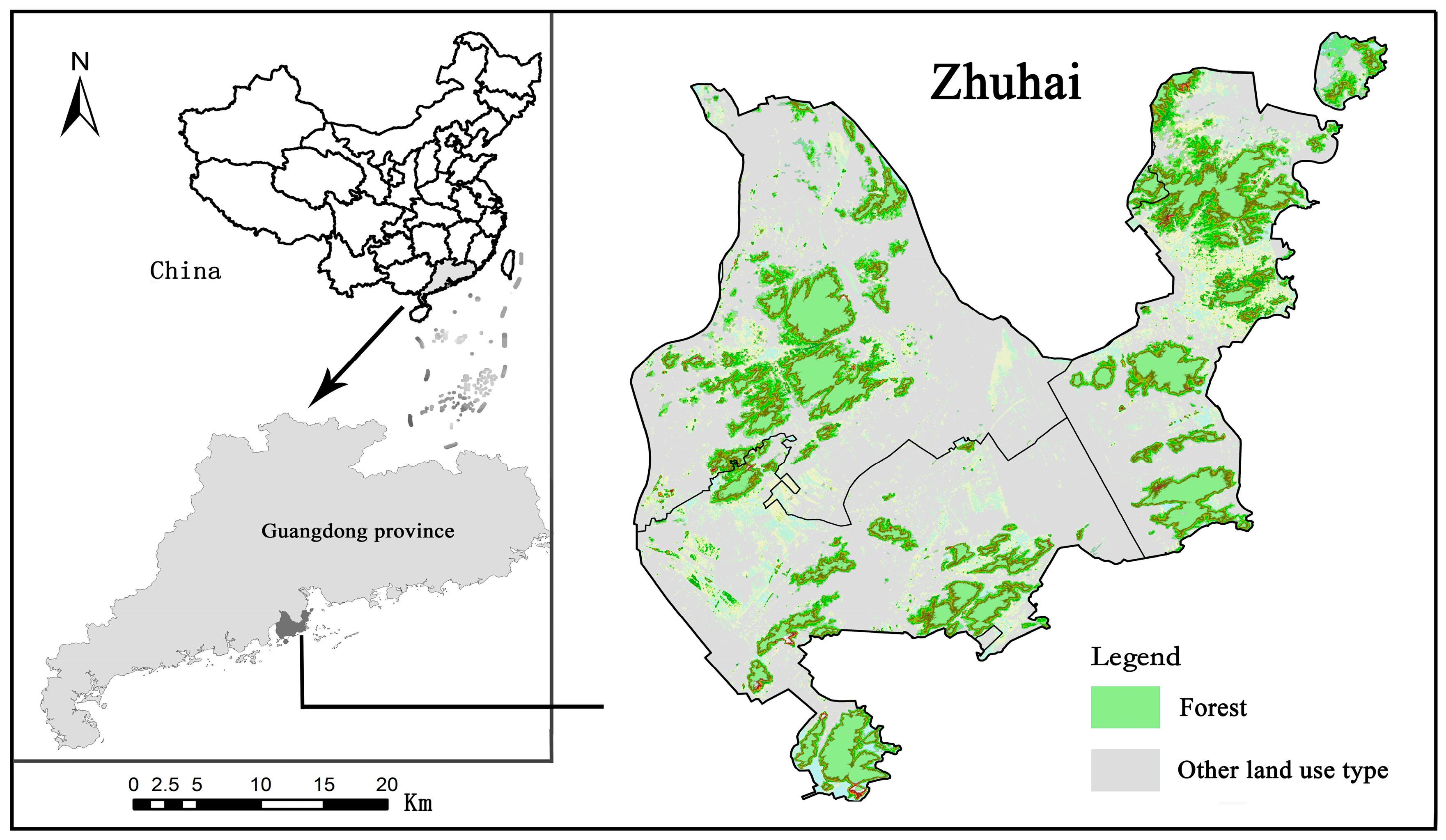

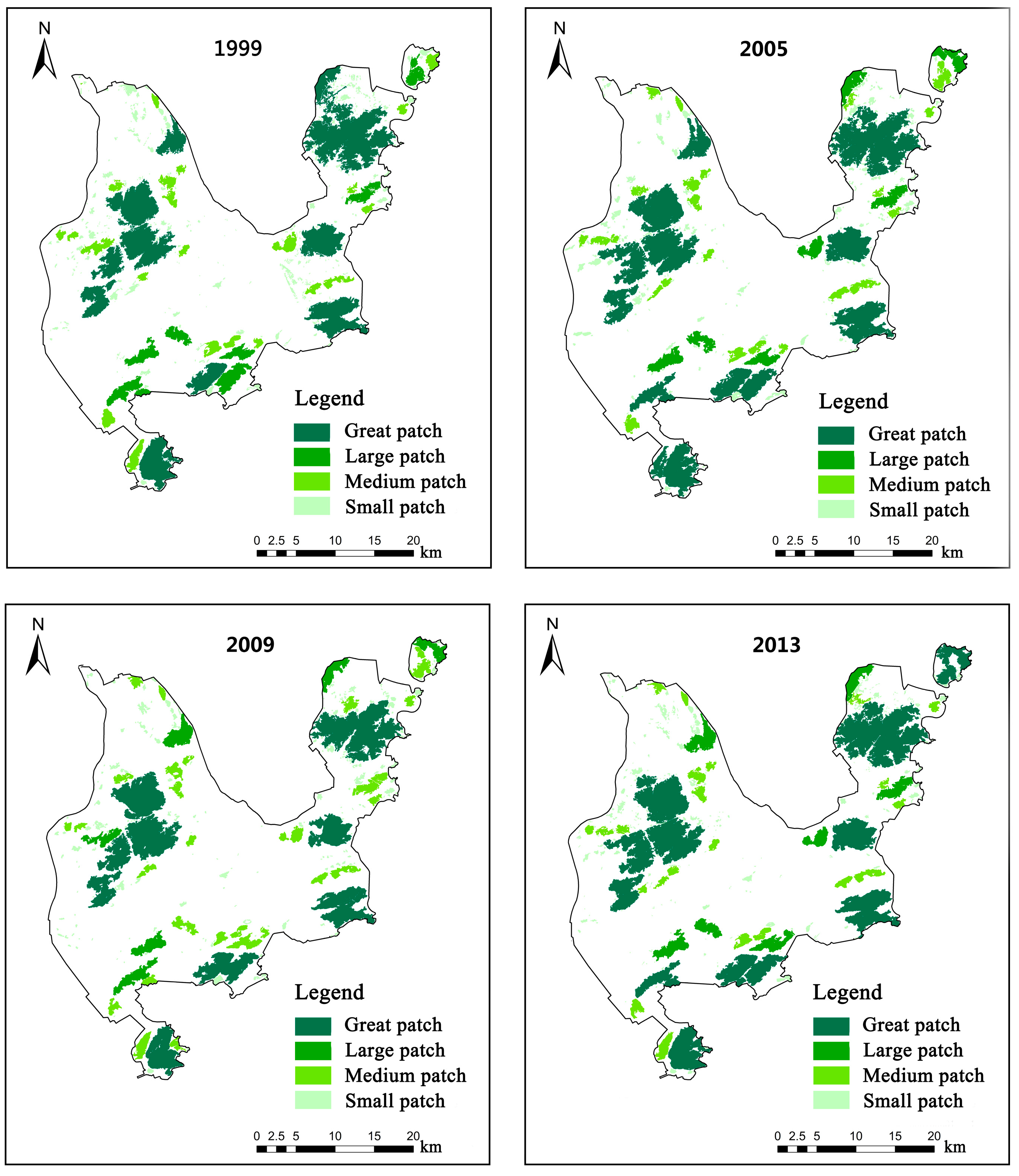

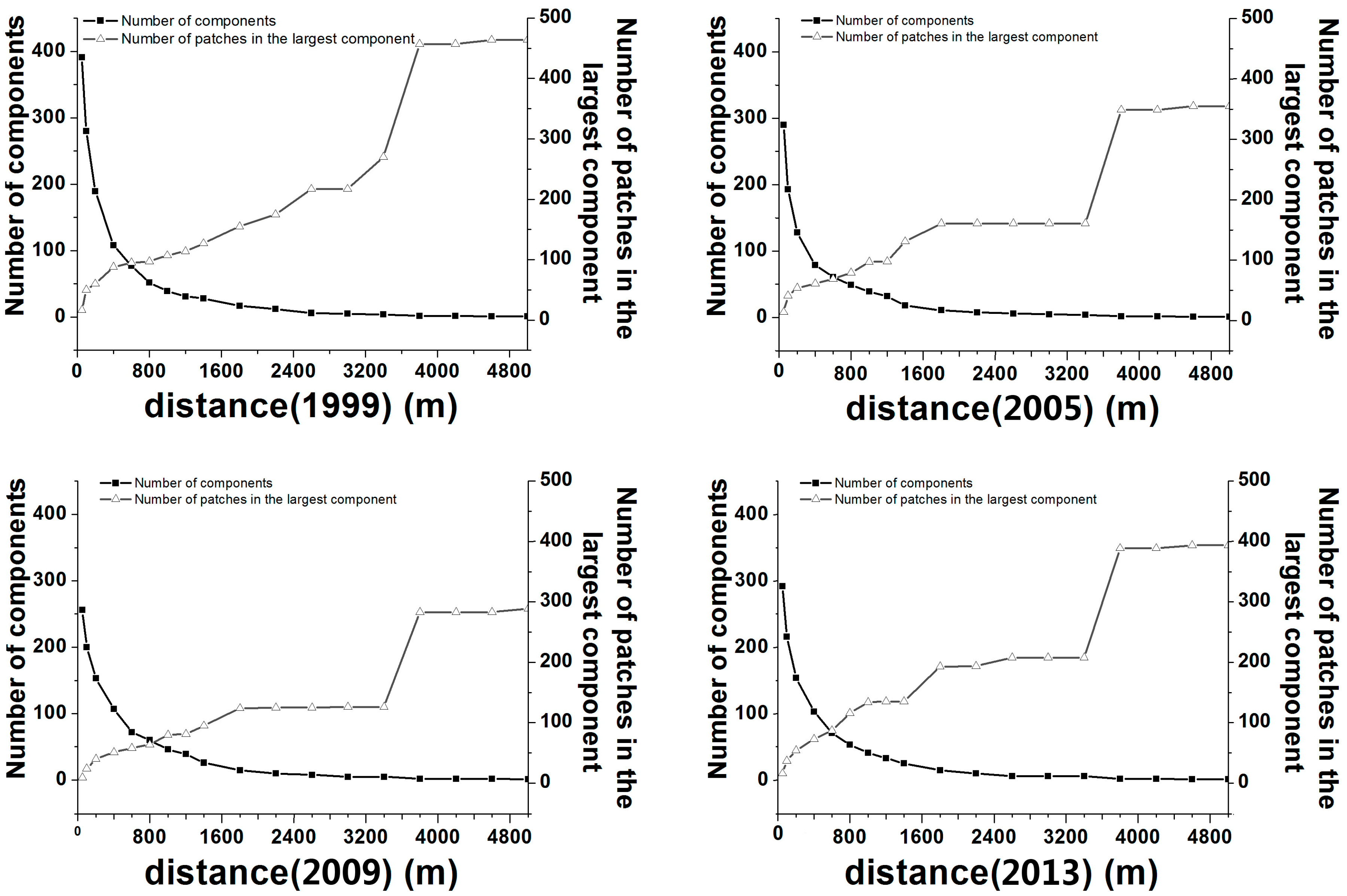
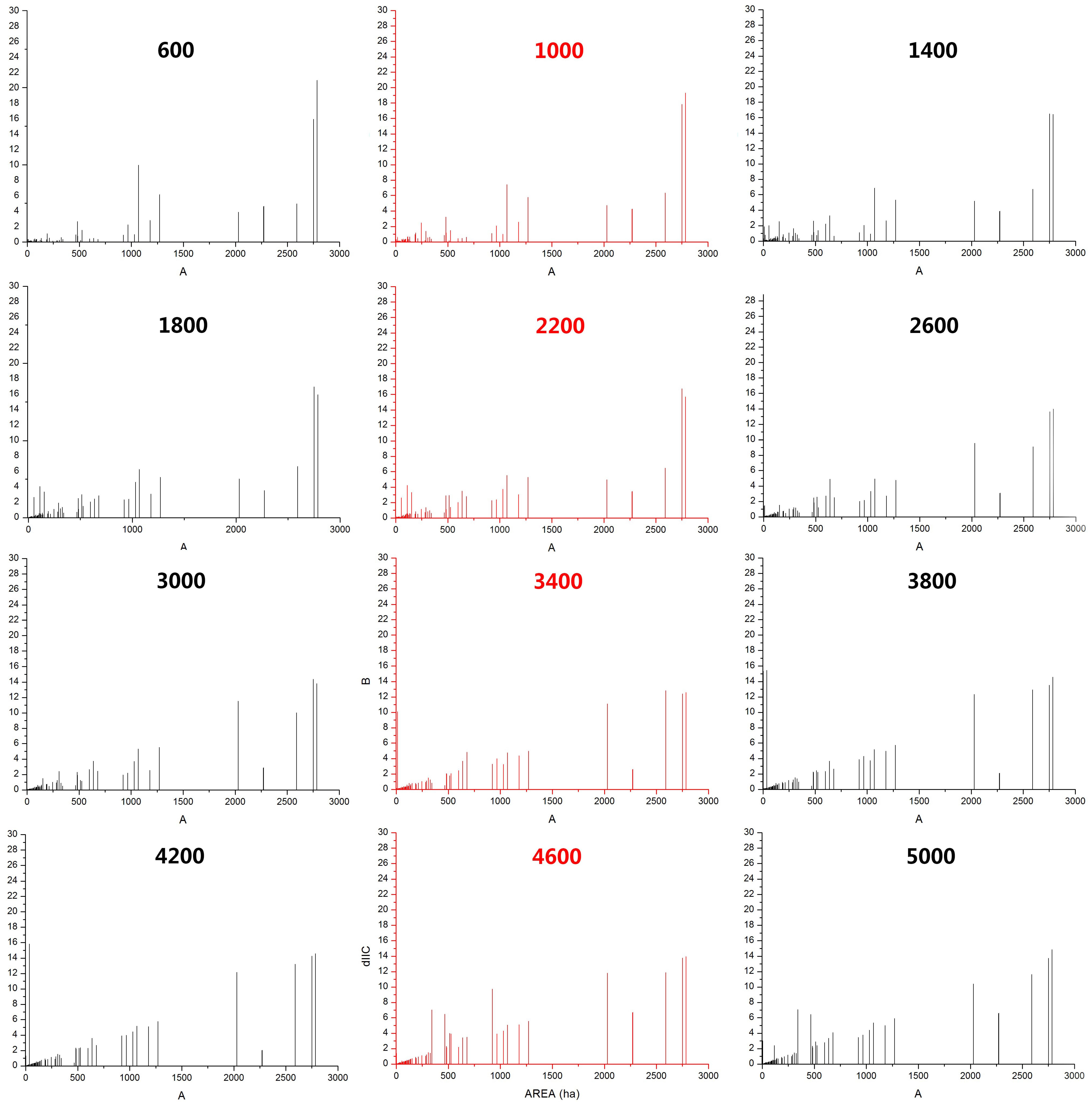
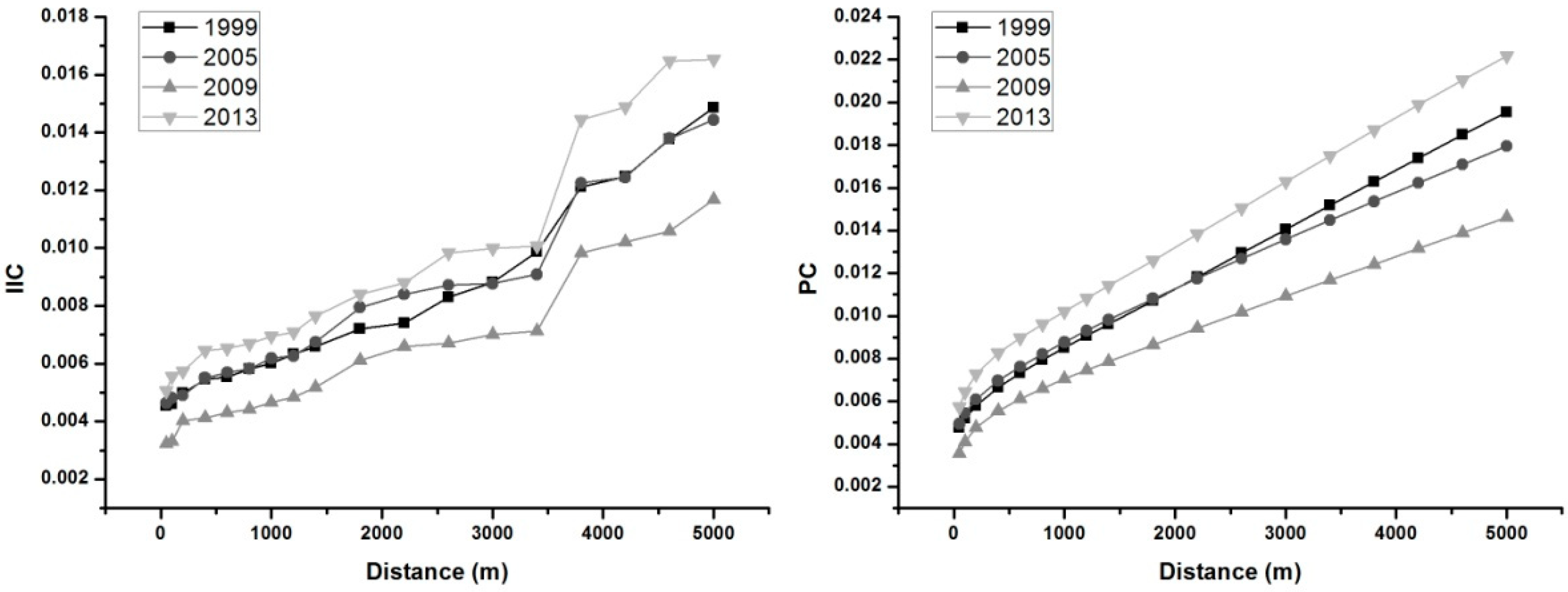
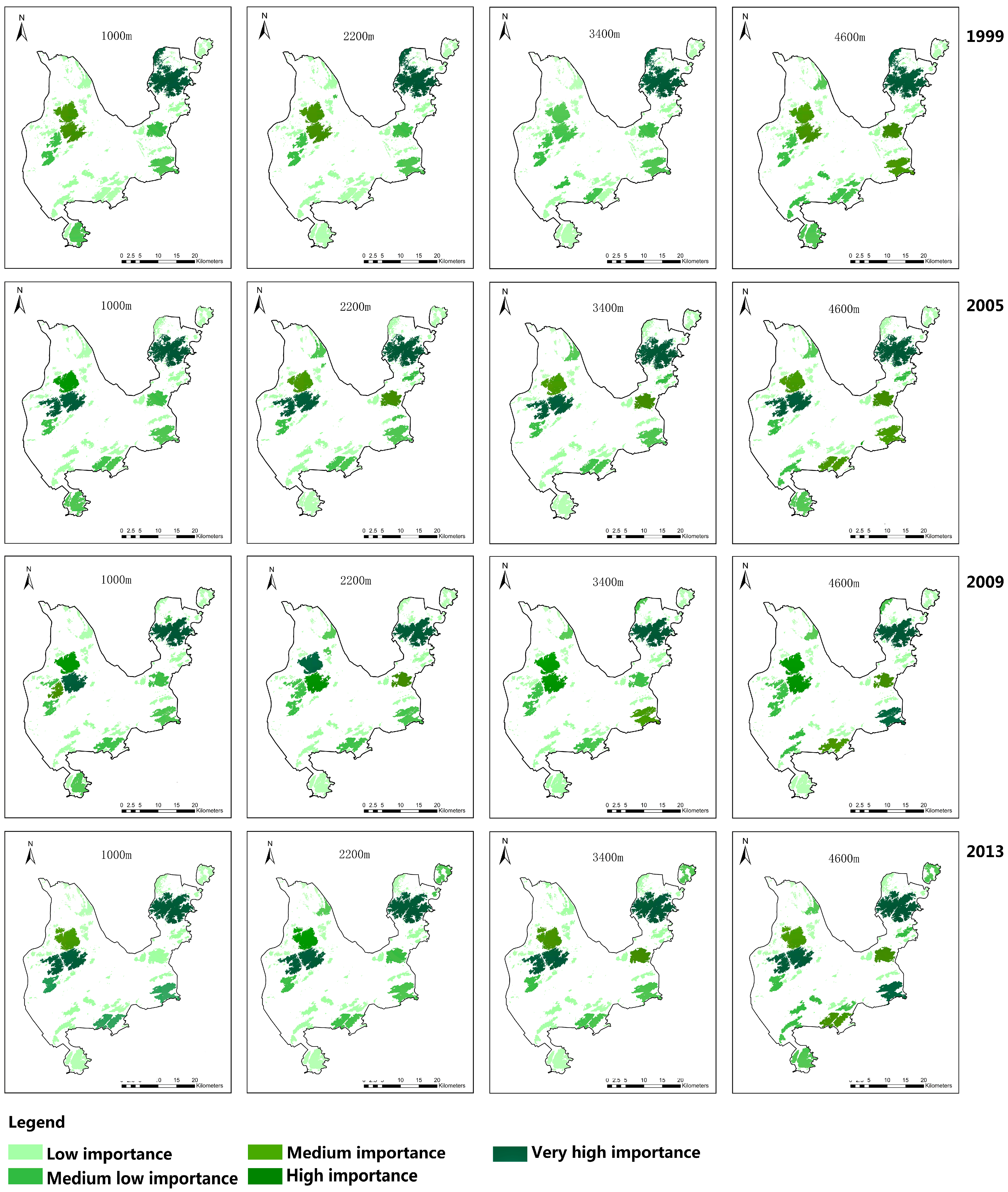
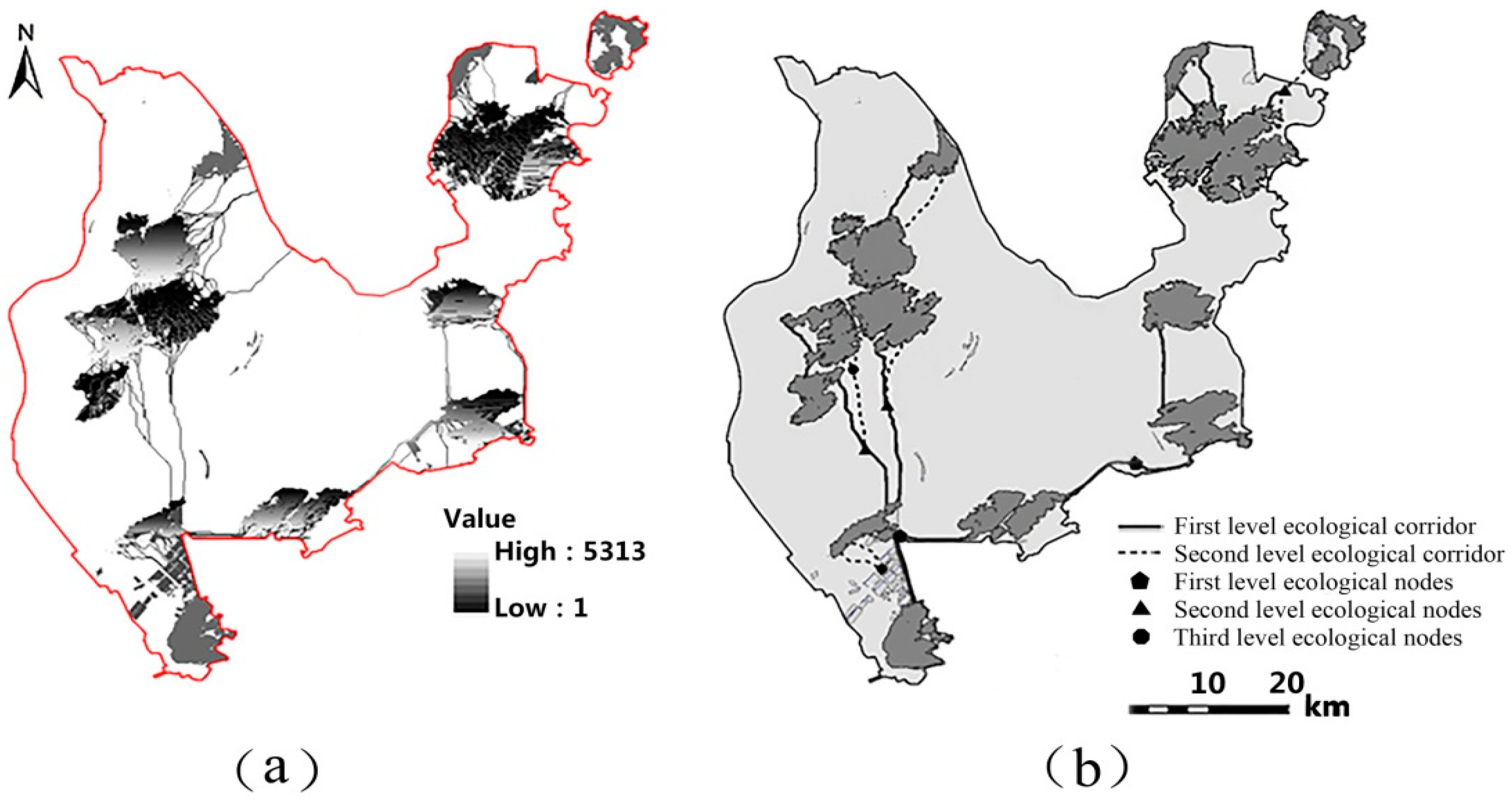
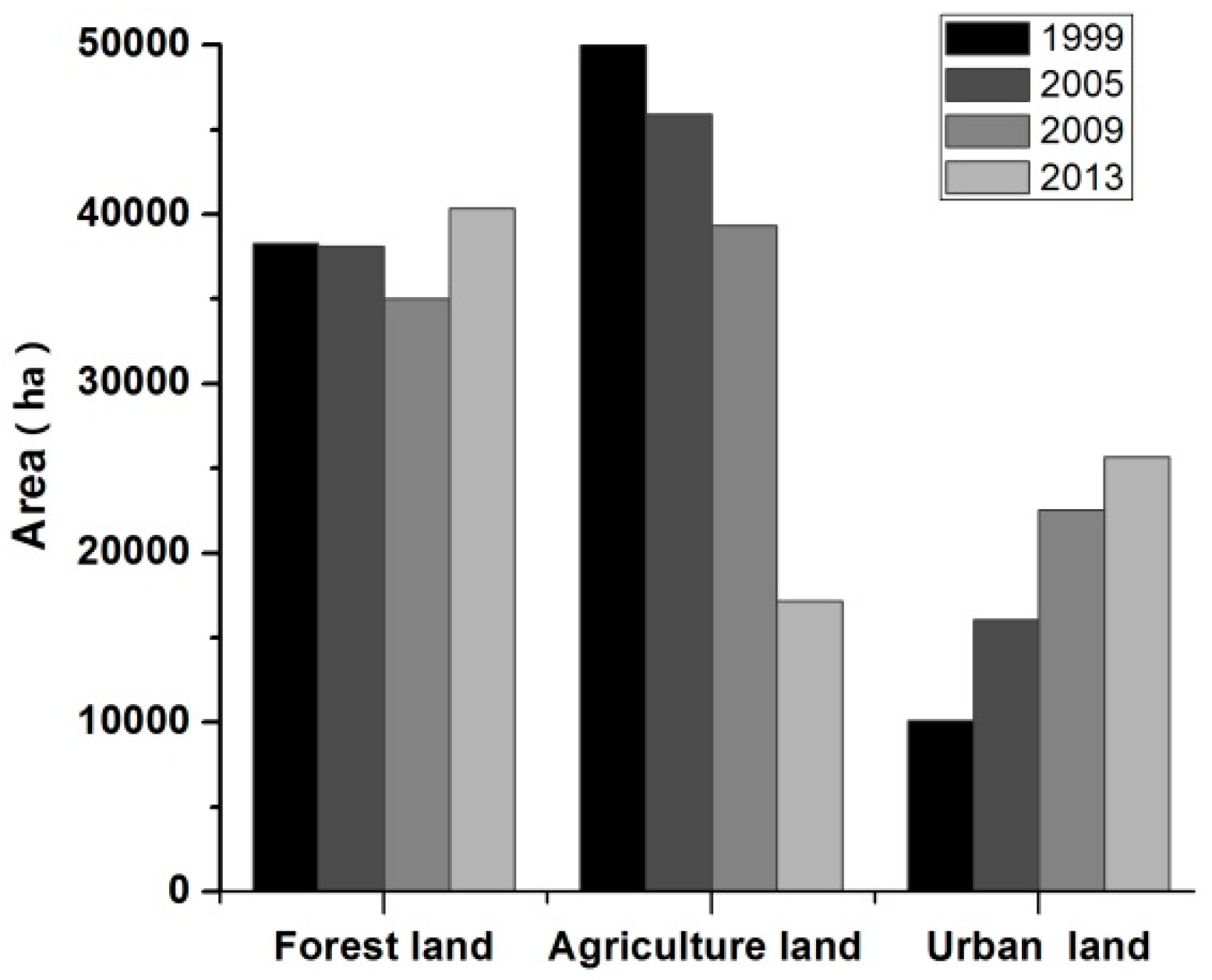
| Number | Image Date | Satellite | Spatial Resolution | Path and Row |
|---|---|---|---|---|
| 1 | 15 November 1999 | LandsatETM+ | 30 m | 122-45/44 |
| 2 | 23 November 2005 | Landsat TM | 30 m | 122-45/44 |
| 3 | 2 November 2009 | Landsat TM | 30 m | 122-45/44 |
| 4 | 7 November 2013 | Landsat TM | 30 m | 122-45/44 |
| Year | Distance (m) | IIC | PC | Distance (m) | IIC | PC |
|---|---|---|---|---|---|---|
| 1999 | 1000 | 0.00601 | 0.00851 | 3400 | 0.00987 | 0.01518 |
| 2005 | 0.00618 | 0.00877 | 0.00909 | 0.01448 | ||
| 2009 | 0.00466 | 0.00704 | 0.00712 | 0.01167 | ||
| 2013 | 0.00695 | 0.01022 | 0.01007 | 0.01749 | ||
| 1999 | 2200 | 0.00743 | 0.01182 | 4600 | 0.01379 | 0.01848 |
| 2005 | 0.00842 | 0.01176 | 0.01377 | 0.01711 | ||
| 2009 | 0.00665 | 0.00942 | 0.01058 | 0.01389 | ||
| 2013 | 0.00879 | 0.01382 | 0.01647 | 0.02104 |
| Year | Patch Importance Indices | 1000 m | Sig | 2200 m | Sig | 3400 m | Sig | 4600 m | Sig |
|---|---|---|---|---|---|---|---|---|---|
| 1999 | dIIC | 0.947 ** | 0 | 0.957 ** | 0 | 0.957 ** | 0 | 0.979 ** | 0 |
| dIICintra | 0.892 ** | 0 | 0.892 ** | 0 | 0.892 ** | 0 | 0.892 ** | 0 | |
| dIICflux | 0.590 ** | 0 | 0.823 ** | 0 | 0.958 ** | 0 | 0.978 ** | 0 | |
| dIICconnector | 0.367 ** | 0 | 0.220 ** | 0 | 0.127 ** | 0.006 | 0.188 ** | 0 | |
| 2005 | dIIC | 0.906 ** | 0.001 | 0.943 ** | 0 | 0.962 ** | 0 | 0.906 ** | 0 |
| dIICintra | 0.920 ** | 0 | 0.920 ** | 0 | 0.920 ** | 0 | 0.920 ** | 0 | |
| dIICflux | 0.738 * | 0.04 | 0.937 ** | 0 | 0.944 ** | 0 | 0.990 ** | 0 | |
| dIICconnector | 0.499 ** | 0.00 | 0.355 ** | 0 | 0.522 ** | 0 | 0.069 | 0.196 | |
| 2009 | dIIC | 0.913 ** | 0 | 0.949 ** | 0 | 0.964 ** | 0 | 0.944 ** | 0 |
| dIICintra | 0.905 ** | 0 | 0.905 ** | 0 | 0.905 ** | 0 | 0.905 ** | 0 | |
| dIICflux | 0.728 ** | 0 | 0.914 ** | 0 | 0.935 ** | 0 | 0.962 ** | 0 | |
| dIICconnector | 0.316 ** | 0 | 0.551 ** | 0 | 0.584 ** | 0 | 0.369 ** | 0 | |
| 2013 | dIIC | 0.904 ** | 0 | 0.940 ** | 0 | 0.966 ** | 0 | 0.950 ** | 0 |
| dIICintra | 0.920 ** | 0 | 0.920 ** | 0 | 0.920 ** | 0 | 0.920 ** | 0 | |
| dIICflux | 0.699 ** | 0 | 0.867 ** | 0 | 0.951 ** | 0 | 0.987 ** | 0 | |
| dIICconnector | 0.538 ** | 0 | 0.459 ** | 0 | 0.584 ** | 0 | 0.323 ** | 0 |
| Year | Patch Importance Indices | 1000 m | Sig | 2200 m | Sig | 3400 m | Sig | 4600 m | Sig |
|---|---|---|---|---|---|---|---|---|---|
| 1999 | dIIC | 0.933 ** | 0 | 0.959 ** | 0 | 0.948 ** | 0 | 0.956 ** | 0 |
| dIICintra | 0.977 ** | 0 | 0.977 ** | 0 | 0.977 ** | 0 | 0.977 ** | 0 | |
| dIICflux | 0.061 | 0.868 | 0.579 | 0.079 | 0.982 ** | 0 | 0.957 ** | 0 | |
| dIICconnector | 0.915 ** | 0 | −0.477 | 0.164 | −0.302 | 0.396 | −0.407 | 0.243 | |
| 2005 | dIIC | 0.868 ** | 0.001 | 0.928 ** | 0 | 0.968 ** | 0 | 0.991 ** | 0 |
| dIICintra | 0.976 ** | 0.000 | 0.976 ** | 0 | 0.976 ** | 0 | 0.976 ** | 0 | |
| dIICflux | 0.654 ** | 0.004 | 0.913 ** | 0 | 0.937 ** | 0 | 0.969 ** | 0 | |
| dIICconnector | 0.786 ** | 0.007 | −0.244 | 0.497 | 0.05 | 0.891 | −0.368 | 0.296 | |
| 2009 | dIIC | 0.821 ** | 0.004 | 0.901 ** | 0 | 0.958 ** | 0 | 0.884 ** | 0 |
| dIICintra | 0.973 ** | 0 | 0.973 ** | 0 | 0.973 ** | 0 | 0.973 ** | 0 | |
| dIICflux | 0.546 | 0.103 | 0.771 ** | 0.009 | 0.922 ** | 0 | 0.964 ** | 0 | |
| dIICconnector | −0.490 | 0.15 | 0.35 | 0.321 | 0.372 | 0.29 | 0.213 | 0.554 | |
| 2013 | dIIC | 0.858 ** | 0.002 | 0.915 ** | 0 | 0.969 ** | 0 | 0.849 ** | 0.002 |
| dIICintra | 0.978 ** | 0 | 0.978 ** | 0 | 0.978 ** | 0 | 0.978 ** | 0 | |
| dIICflux | 0.570 | 0.086 | 0.717 | 0.02 | 0.952 ** | 0 | 0.958 ** | 0 | |
| dIICconnector | 0.928 ** | 0 | −0.041 | 0.911 | 0.461 | 0.180 | −0.011 | 0.976 |
© 2018 by the authors. Licensee MDPI, Basel, Switzerland. This article is an open access article distributed under the terms and conditions of the Creative Commons Attribution (CC BY) license (http://creativecommons.org/licenses/by/4.0/).
Share and Cite
Cui, N.; Feng, C.-C.; Wang, D.; Li, J.; Guo, L. The Effects of Rapid Urbanization on Forest Landscape Connectivity in Zhuhai City, China. Sustainability 2018, 10, 3381. https://doi.org/10.3390/su10103381
Cui N, Feng C-C, Wang D, Li J, Guo L. The Effects of Rapid Urbanization on Forest Landscape Connectivity in Zhuhai City, China. Sustainability. 2018; 10(10):3381. https://doi.org/10.3390/su10103381
Chicago/Turabian StyleCui, Nan, Chen-Chieh Feng, Dan Wang, Jianfei Li, and Luo Guo. 2018. "The Effects of Rapid Urbanization on Forest Landscape Connectivity in Zhuhai City, China" Sustainability 10, no. 10: 3381. https://doi.org/10.3390/su10103381
APA StyleCui, N., Feng, C.-C., Wang, D., Li, J., & Guo, L. (2018). The Effects of Rapid Urbanization on Forest Landscape Connectivity in Zhuhai City, China. Sustainability, 10(10), 3381. https://doi.org/10.3390/su10103381





